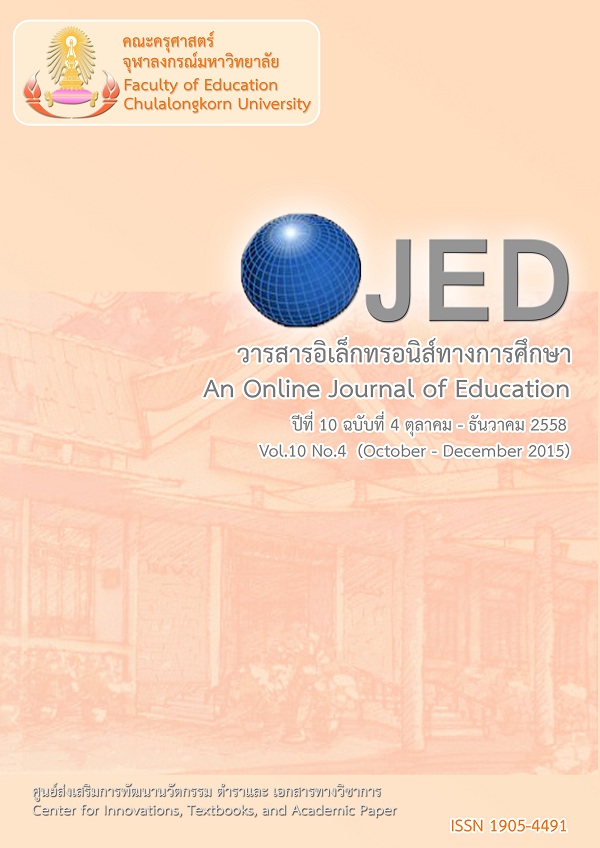แนวทางดำเนินงานในการพัฒนาอัตลักษณ์ของนักเรียน: กรณีศึกษาโรงเรียนปฏิบัติดี
Keywords:
แนวทางดำเนินงาน, การพัฒนา, อัตลักษณ์, กรณีศึกษา, โรงเรียนปฏิบัติดี, GUIDELINES / DEVELOPING / IDENTITY / CASE STUDIES / GOOD PRACTICES SCHOOLSAbstract
การวิจัยครั้งนี้มีวัตถุประสงค์เพื่อ (1) สังเคราะห์อัตลักษณ์และจัดประเภทอัตลักษณ์ของนักเรียนในสถานศึกษาที่ได้รับการประเมินภายนอกรอบสาม (2) วิเคราะห์เปรียบเทียบอัตลักษณ์ของนักเรียนในสถานศึกษาที่มีขนาด ระดับ สังกัด ที่ตั้งและภูมิภาคแตกต่างกัน (3) ศึกษาความสัมพันธ์ระหว่างอัตลักษณ์ของนักเรียนที่สถานศึกษากำหนดและคุณภาพของผู้เรียนที่เกิดขึ้น และ (4) ศึกษาแนวทางการดำเนินงานของสถานศึกษาที่มีการปฏิบัติที่ดี ประชากรที่ใช้คือสถานศึกษาขั้นพื้นฐานที่ได้รับการประเมินภายนอกรอบสาม ทั่วประเทศจำนวน 9,699 โรงเรียน เครื่องมือที่ใช้ในการวิจัยครั้งนี้แบ่งเป็น 2 ช่วง ในช่วงแรกเป็นเครื่องมือที่ใช้ในการวิเคราะห์เชิงปริมาณ คือแบบบันทึกข้อมูล วิเคราะห์ข้อมูลโดยการวิเคราะห์ค่าสถิติพื้นฐาน การวิเคราะห์ไค-สแควร์ ด้วยโปรแกรม Microsoft Excel ส่วนช่วงที่สองศึกษาข้อมูลเชิงคุณภาพ โดยนำผลการศึกษาจากข้อมูลเชิงปริมาณในช่วงแรก มาพิจารณาคัดเลือกกรณีศึกษา จำนวน 6 โรงเรียน เครื่องมือที่ใช้ในการวิเคราะห์เชิงคุณภาพคือแบบสัมภาษณ์ชนิดไม่มีโครงสร้างและแบบสังเกต วิเคราะห์ข้อมูลโดยใช้การวิเคราะห์เนื้อหา ผลการวิจัยที่สำคัญสรุปได้ดังนี้ (1) การกำหนดอัตลักษณ์ของนักเรียนแบ่งออกเป็น 3 กลุ่ม ได้แก่ กลุ่มที่เน้นอัตลักษณ์เพียงด้านเดียว กลุ่มที่เน้นอัตลักษณ์ทั้งสองด้าน และกลุ่มที่เน้นอัตลักษณ์ทั้งสามด้าน (ดี เก่งและมีความสุข) (2) โรงเรียนที่มีขนาด ระดับ สังกัด ที่ตั้งและภูมิภาคต่างกันมีการกำหนดอัตลักษณ์ด้านความดีมากกว่าด้านอื่นๆ (3) คุณภาพของผู้เรียนมีความสัมพันธ์ทางบวกกับอัตลักษณ์ของนักเรียนตามที่สถานศึกษากำหนด (4) แนวทางการดำเนินงานของสถานศึกษาที่มีการปฏิบัติที่ดี ส่งเสริมให้มีการทำกิจกรรมที่เกี่ยวข้องในด้านต่างๆ อย่างต่อเนื่อง โดยมีการกำหนดของโครงการหรือกิจกรรมที่สอดคล้องกับอัตลักษณ์ในแต่ละด้าน มีการประเมินสภาพปัญหา และมีการประเมินผล
This research aims to: 1) to synthesize and categorize student identity in good practices schools which passed the third external evaluation, 2) to compare student identity with different school size, students’ educational level, authorized office, location and regional, 3) to study relationship between the student identity which school determined and the actual quality of students, and 4) to study the process of implementation in good practices school. The population of this research is 9,699 the third passed external evaluation schools from all over the country. The instruments consists 2 parts; First quantitative part, quantitative analysis analyzes by using record form, descriptive statistics, Chi-square. Part 2, qualitative part, selecting 6 schools from research’s part 1 output and continuing research by content analysis method that instruments are informal interview, research coding form and observation notes.
The research results were as follows: 1) Student identity dimensions (Moral, Achievement, Happiness ) were 3 groups such as 1-sided identity, 2-sided identity, 3-sided identity, 2) There was founded small school, primary school, schools under the authority of the Office of the Basic Education Commission, suburban school and school in North-east have identified student moral identity dimensions higher than the others, 3) There was positive relationship between student’s quality and student identity that school decided, 4) The process of implementation in good practices schools let them have many good continuous activities consistent with each student identity aspect; moreover, this process, as was evaluated problem and output.




